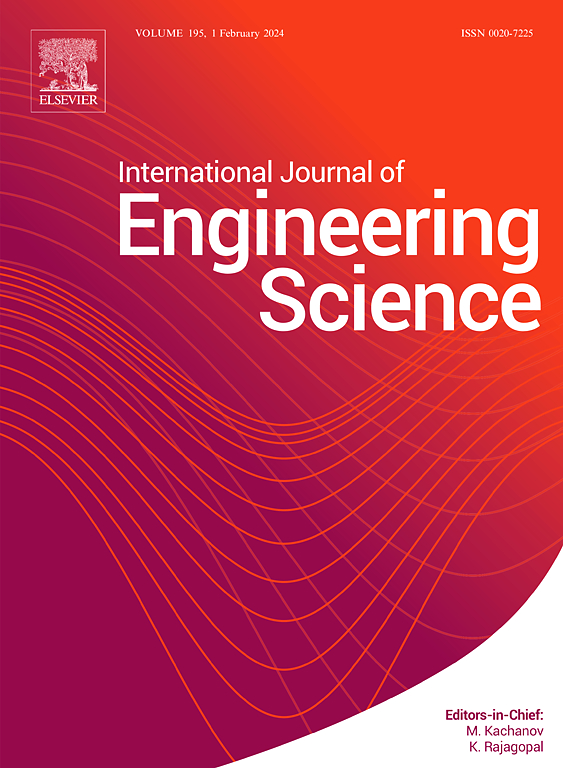超材料梁的表面驱动计算均匀化方法
IF 5.7
1区 工程技术
Q1 ENGINEERING, MULTIDISCIPLINARY
International Journal of Engineering Science
Pub Date : 2025-06-06
DOI:10.1016/j.ijengsci.2025.104313
引用次数: 0
摘要
超材料表现出超越其组成材料和传统本构关系的非凡力学性能,主要是由于其微观结构单元及其相互作用的独特特性。然而,传统的同质化方法往往无法捕捉到这些显著的行为。本研究探讨了微结构单元对超材料梁的尺寸相关弯曲响应的影响,将观察到的影响归因于微结构诱导的表面弹性。构建了全厚度代表体积单元(RVE),并建立了表面驱动计算均质化方法(CHM)来准确表征微观结构引起的表面效应。均匀化弹性模型中的表面厚度参数使用高保真度,高通量基于fem的全厚度RVE均匀化进行校准。通过预先计算各种全厚度rve的有效特性和表面厚度数据集,开发的均匀化模型能够有效和准确地在线预测超材料束的行为。结果表明,该方法考虑了与微观结构相关的表面厚度,可以有效准确地捕获超材料梁的力学响应。该模型明显优于忽略表面效应的经典均匀化模型,特别是在宏观弯曲变形方面。本文章由计算机程序翻译,如有差异,请以英文原文为准。
Surface-driven computational homogenization method for metamaterial beams
Metamaterials exhibit extraordinary mechanical properties that surpass those of their constituent materials and conventional constitutive relationships, primarily due to the unique characteristics of their microstructural units and their interactions. However, traditional homogenization methods often fail to capture these remarkable behaviors. This study explores the influence of microstructural units on the size-dependent bending response of metamaterial beams, attributing the observed effects to microstructure-induced surface elasticity. A full-thickness representative volume element (RVE) is constructed, and a surface-driven computational homogenization method (CHM) is developed to accurately characterize the microstructure-induced surface effects. The surface thickness parameters in the homogenized elastic model are calibrated using high-fidelity, high-throughput FEM-based homogenization of the full-thickness RVE. By precomputing a dataset of effective properties and surface thicknesses for various full-thickness RVEs, the developed homogenization model enables efficient and accurate online predictions of metamaterial beam behavior. The results demonstrate that the developed homogenization method, incorporating microstructure-dependent surface thickness, can effectively and accurately capture the mechanical response of metamaterial beams. The proposed model significantly outperforms classical homogenization model that neglect surface effects, particularly in macroscopic bending deformation.
求助全文
通过发布文献求助,成功后即可免费获取论文全文。
去求助
来源期刊

International Journal of Engineering Science
工程技术-工程:综合
CiteScore
11.80
自引率
16.70%
发文量
86
审稿时长
45 days
期刊介绍:
The International Journal of Engineering Science is not limited to a specific aspect of science and engineering but is instead devoted to a wide range of subfields in the engineering sciences. While it encourages a broad spectrum of contribution in the engineering sciences, its core interest lies in issues concerning material modeling and response. Articles of interdisciplinary nature are particularly welcome.
The primary goal of the new editors is to maintain high quality of publications. There will be a commitment to expediting the time taken for the publication of the papers. The articles that are sent for reviews will have names of the authors deleted with a view towards enhancing the objectivity and fairness of the review process.
Articles that are devoted to the purely mathematical aspects without a discussion of the physical implications of the results or the consideration of specific examples are discouraged. Articles concerning material science should not be limited merely to a description and recording of observations but should contain theoretical or quantitative discussion of the results.
 求助内容:
求助内容: 应助结果提醒方式:
应助结果提醒方式:


